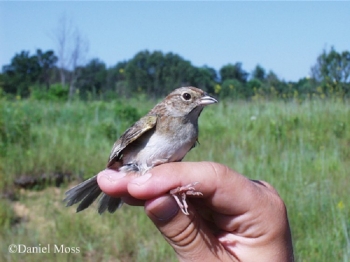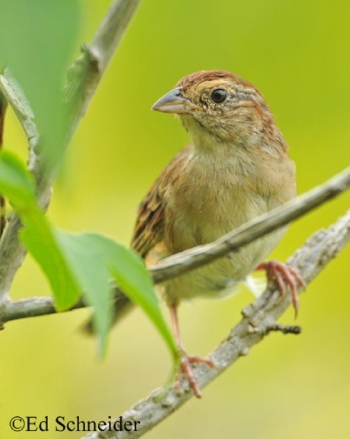Bachman's Sparrow, Peucaea aestivalis
The Bachman's Sparrow is a fairly drab, secretive sparrow and has become extremely rare in Tennessee. Together with the Red-cockaded Woodpecker, they inhabited mature pine forest near the northern limit of their ranges. That habitat and the Red-cockaded Woodpecker are now gone from the state, and the Bachman's Sparrow is nearly extirpated.
This bird requires habitat with a high volume of grasses and forbs, some scattered trees and shrubs, and an open understory on dry, upland sites. Only occasionally do these conditions exist in clear-cuts, abandoned fields, and possibly newly planted commercial pine plantations. These sites usually remain suitable for only 3 to 5 years unless they are regularly thinned and burned to reduce understory vegetation.
Bachman's Sparrow is only present in the breeding season from April through August, and rarely into October. It was listed as Endangered by the State of Tennessee in 1975.
Description: The Bachman's Sparrow is a fairly large sparrow with a stout bill and long, rounded tail. The crown, hindneck, and a stripe extending behind the eye are streaked and bright rusty-brown, the eyebrow line, throat, and chest are light gray, and the upper tail is dark brown. The eye is dark brown, the bill is gray, and the legs dull yellow or pinkish. Males and females look the same.
Length: 6"
Wingspan: 7.25"
Weight: 0.68 oz
Voice: The song is a simple, clear whistle with a musical trill, and each successive song differs slightly in pitch.
Similar Species:
- American Tree Sparrows, irregular winter visitors to Tennessee, are larger and have a dark central chest-spot.
- Field Sparrows have a plain face, a thin white eye-ring, and a bright pink bill.
- Chipping Sparrows in summer, have a bright rusty cap, and a dark line through the eye.
Habitat: Open mature pine woods, grassy old fields, young clear-cuts, abandoned farmland, and occasionally young commercial pine plantations. These habitats must have a high volume of grasses and forbs, some scattered trees and shrubs, and an open understory on dry, upland sites. Most habitats remain suitable for only 3 to 5 years unless regularly thinned and burned to reduce understory vegetation.
Diet: Grass and other small seeds, and insects.
Nesting and reproduction: In Tennessee, Bachman's Sparrows have a relatively long breeding season lasting from late April into mid-August.
Clutch Size: Usually 3 to 5 eggs, with 4 or 5 eggs most common in Tennessee.
Incubation: The female incubates the eggs for 12 to 14 days.
Fledging: Both adults feed the nestlings, which fledge in about 9 days.
Nest: The nest is built primarily of grasses, and is usually domed with a side entrance. It is built on the ground at the base of a clump of grass, or other low vegetation.
Status in Tennessee: The Bachman's Sparrow was listed as Endangered by the State of TN in 1975. This bird is nearly extirpated from the state. A small population currently breeds in restricted areas at Fort Campbell in Stewart and Montgomery Counties. Recent sightings include at least one bird south of Wattendorf Memorial Highway at Arnold Engineering Development Center (AEDC) in Franklin County in late May 2008, and two birds at two different sites were found in Wayne County in July 2010. Both the 2008 and 2010 birds responded to playback but did not sing. Formerly bred in Roane, Fentress, Scott, Morgan, Chester, Hardin, Lawrence, and Lewis Counties.
Dynamic map of Bachman's Sparrow eBird observations in Tennessee
Fun Facts:
- Bachman's Sparrow was originally described in 1834 by John J. Audubon. He named the species after his friend John Bachman (1790-1874), a Charleston clergyman who discovered the species near Charleston, South Carolina.
- The Bachman's Sparrow is the only sparrow that is endemic to the United States.
- In 2010 the American Ornithologists' Union changed the genus of Bachman's Sparrow from Aimophila to Peucaea.
- Habitat loss is likely the greatest threat facing this species.
Best places to see in Tennessee: The breeding sites on Fort Campbell in Stewart and Montgomery Counties are unfortunately in restricted areas not open to the public. There are no other recent confirmed breeding locations.

